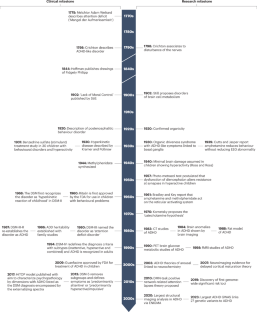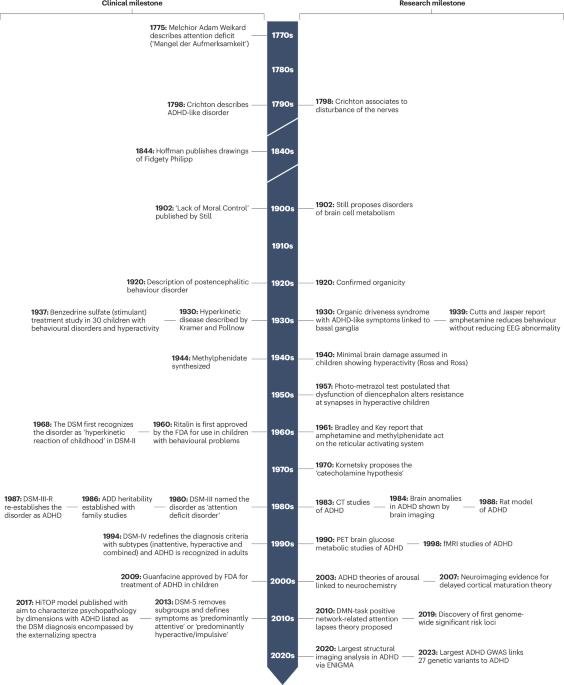注意缺陷多动障碍的神经生物学:历史挑战与新兴前沿
IF 26.7
1区 医学
Q1 NEUROSCIENCES
引用次数: 0
摘要
从遗传学到行为学研究等多个层面的广泛调查试图揭示注意力缺陷多动障碍(ADHD)的机理基础,以期开发出有效的治疗方法。尽管做出了这些努力,但注意力缺陷多动障碍(ADHD)的发病机制仍然难以捉摸。在这篇综述中,我们回顾了已了解到的有关多动症的知识,同时还提供了一个框架,可作为未来研究的路线图。我们强调,ADHD 是一种具有多种病因的高度异质性疾病,因此需要一种多因素维度表型,而不是一种固定的二分法概念。我们强调了一些新发现,这些新发现表明,应从更加全脑、"全局 "的角度来看待多动症,而不是传统的局部化框架,后者认为多动症是由一组有限的大脑区域或网络引起的。最后,我们强调,长期以来,那些旨在将神经生物学与多动症表型联系起来的研究一直未能取得进展。然而,ADHD 研究进入了一个新时代,其表型的完善、方法的先进、研究设计的创新以及研究力量的充足,正开始为这一领域奠定良好的基础。事实上,该领域正处于一个大有希望的关口,可以推进对多动症的神经生物学理解,并实现临床应用的承诺。本文章由计算机程序翻译,如有差异,请以英文原文为准。


Neurobiology of attention-deficit hyperactivity disorder: historical challenges and emerging frontiers
Extensive investigations spanning multiple levels of inquiry, from genetic to behavioural studies, have sought to unravel the mechanistic foundations of attention-deficit hyperactivity disorder (ADHD), with the aspiration of developing efficacious treatments for this condition. Despite these efforts, the pathogenesis of ADHD remains elusive. In this Review, we reflect on what has been learned about ADHD while also providing a framework that may serve as a roadmap for future investigations. We emphasize that ADHD is a highly heterogeneous disorder with multiple aetiologies that necessitates a multifactorial dimensional phenotype, rather than a fixed dichotomous conceptualization. We highlight new findings that suggest a more brain-wide, ‘global’ view of the disorder, rather than the traditional localizationist framework, which asserts that a limited set of brain regions or networks underlie ADHD. Last, we underscore how underpowered studies that have aimed to associate neurobiology with ADHD phenotypes have long precluded the field from making progress. However, a new age of ADHD research with refined phenotypes, advanced methods, creative study designs and adequately powered investigations is beginning to put the field on a good footing. Indeed, the field is at a promising juncture to advance the neurobiological understanding of ADHD and fulfil the promise of clinical utility. Attention-deficit hyperactivity disorder (ADHD) is a prevalent neurodevelopmental condition that is poorly understood at a neurobiological level. In this Review, Fair and colleagues examine studies of ADHD neurobiology and provide a perspective on how the field may move forward.
求助全文
通过发布文献求助,成功后即可免费获取论文全文。
去求助
来源期刊

Nature Reviews Neuroscience
NEUROSCIENCES-
自引率
0.60%
发文量
104
期刊介绍:
Nature Reviews Neuroscience is a multidisciplinary journal that covers various fields within neuroscience, aiming to offer a comprehensive understanding of the structure and function of the central nervous system. Advances in molecular, developmental, and cognitive neuroscience, facilitated by powerful experimental techniques and theoretical approaches, have made enduring neurobiological questions more accessible. Nature Reviews Neuroscience serves as a reliable and accessible resource, addressing the breadth and depth of modern neuroscience. It acts as an authoritative and engaging reference for scientists interested in all aspects of neuroscience.
 求助内容:
求助内容: 应助结果提醒方式:
应助结果提醒方式:


